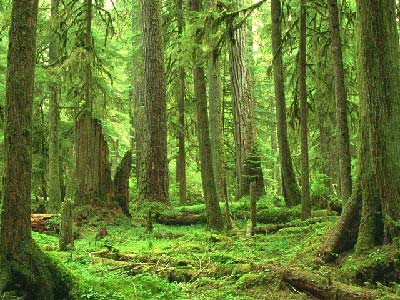

Old Forest (2005)
for
Piano and Orchestra
by
Robert Morris
Program Notes
After attending the National Convention of the Society of Music Theory in Seattle, in November in 2004, my old friend Wayne Slawson and I took a three day outing to visit locations on the Olympic Peninsular or Washington State. We spent an afternoon walking in the Hoh river rain forest area in Olympic National Park. I was overcome by the sheer beauty of the scene: incredible colors amid wetness, mists and rain here and there, vines, mosses draped on trees, a myriad of flowers and plants penetrating through the green--actually gaudy. Amid cries of birds and the sound of rustling leaves there was a sound of a river that was running roughly parallel to the path. Sometimes we would get near to it and be able to see it, and spend some time sitting on a rock, talking; at other places, it was barely audible. Immediately the idea of a piece for piano and orchestra came into my mind, where the piano--or perhaps the orchestra--is the river, always playing, and the various places on the trail are represented by the other part.
After I returned home, I began making the materials for the piece. Like many of recent pieces, Old Forest is based on a 50 note string of pitches containing each hexachordal harmony once. After finding a suitable string by computer search and composing the basic note arrays, I produced two structures. The first is for the piano consisting of a seven-voice, continuously flowing, contrapuntally web of notes; the second for the orchestra is a much slowly evolving harmonic texture. The result is a piece in which the piano is almost always chattering, sometimes giving the impression of cocktail piano playing, a bubbling along, while a more sedate, even serious music dominates the various orchestral passages. The piano is almost impervious, almost inappropriately mercurial, suggesting abundance and fecundity. This sense of overflow is heightened as one gets to know the music, as every passage in the piano (and orchestra, too) has one or more mirrors someplace else in the piece.
The work is in one long movement, divided into three long sections. At the end of each section, the piano, sometimes accompanied by a few solo instruments, plays a six-part canon derived from the generating string. The string is heard perhaps most clearly in the middle of the piece, when a slow, relentless series of overlapped notes in the orchestra enclose the piano's wild gestures and motives. These notes in order are the string.